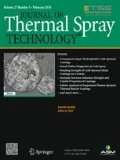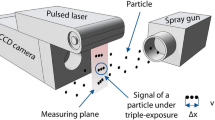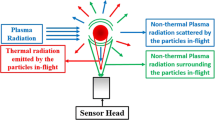Abstract
The influences of the dimensions of optical components and the trajectories of spray particles on the variations of the waveforms of the radiation signals from the spray particles were studied both theoretically and experimentally for correct simultaneous measurement of the particle parameters including particle velocity, surface temperature, size, and spatial distribution. Two types of filtering masks, including single-windowed and dual-windowed, were used as models in the current study. The evolution of the radiation pulse from a moving thermal spray particle was simulated through the change of the projected area of the particle image spot on the filtering mask window. The experimental detection of the thermal radiation pulses was performed for the high velocity oxygen fuel (HVOF) process using an optoelectronic measurement system.
The theoretical simulation clearly showed that the characteristic waveforms of the thermal radiation signals from the spray particles are varied with the distance and orientation of the trajectories of thermal spray particles with respect to the ideal image plane of the filtering window plane. The typical variations of the characteristic waveforms obtained theoretically have been observed experimentally with HVOF spraying. The waveforms expected theoretically were correlated well with those observed experimentally.
The characteristic waveforms of the radiation signals from the spray particles in a trapezoid shape with a saturated top platform contain the information for spray particle parameters including velocity, surface temperature, size, and spatial distribution. With the dual-windowed filtering mask, the particle velocity can be correctly measured with the bi-peak radiation signal in triangle-like shape, and the surface temperature may be estimated reasonably. However, the particle size cannot be estimated correctly. It was revealed that the characteristics of the waveforms were remarkably influenced by the image spot size. Therefore, the expansion of the image spot based on the relation between the image spot size of an in-flight particle and optical lens parameters obtained optically was discussed. The influence of the image spot size on the waveform characteristics was examined.
Similar content being viewed by others
References
S. Kuroda, H. Fujimori, T. Fukushima, and S. Kitahara: “Measurement of Temperature and Velocity of Thermally Sprayed Particles Using Thermal Radiation,” Trans. Japan. Welding Soc., 1991, 22(2), pp. 82–88.
A. Vardelle, M. Vardelle, R. McPherson, and P. Fauchais: “Study on Influence of Particle Temperature and Velocity Distribution Within a Plasma Jet Coating Formation” in Proceedings of 9th International Thermal Spraying Conference, Hague, Netherlands, 1989, pp. 30–33.
H.D. Steffens, K.H. Busse, and M. Schneider: “Spray Particle Behavior in a Low Pressure Plasma Jet” in Proceedings of 11th International Thermal Spraying Conference, Canada Welding Society, 1986, pp. 49–59.
L. Pawlowski: The Science and Engineering of Thermal Spray Coatings, John Wiley & Sons Inc., New York, NY, 1995, pp. 103–05.
V.P. Lyagushkin and O.P. Solonenko: “A Method to Simultaneously Measure the Velocity and Temperature of Disperse Particles in High Temperature Flow” in Proceedings of 7th International Conference on Plasma Chemistry, Eindhoven, Netherlands, Vol. 2, 1985, pp. 730–35.
C. Moreau, P. Gougeon, M. Lamontagne, V. Lacasse, G. Vaudreuil, and P. Cielo: “On-Line Control of the Plasma Spraying Process by Monitoring the Temperature, Velocity and Trajectory of In-Flight Particles” in Thermal Spray Industrial Applications, C. C. Berndt and S. Sampath, ed., ASM International, Materials Park, OH, 1994, pp. 431–37.
L. Leblanc, P. Gougeon, and C. Moreau: “Investigation of the Long-Term Stability of Plasma Spraying by Monitoring Characteristics of the Spray Particles” in Thermal Spray: A United Forum for Scientific and Technological Advances, C.C. Berndt, ed., ASM International, Materials Park, OH, 1997, pp. 567–75.
M.P. Planche, R. Bolot, O. Landemarre, and C. Coddet: “Comparison Between Experimental and Numerical Results Obtained on In-Flight Particles Characteristics” in Thermal Spray: Meeting the Challenges of the 21st Century, C. Coddet, ed., ASM International, Materials Park, OH, 1998, pp. 355–60.
M. Schutz, G. Barbezat, and E. Fluck: “Measurement Technology for In-Flight Particle Diagnosis in Plasma Spraying” in Thermal Spray: Meeting the Challenges of the 21st Century, C. Coddet, ed., ASM International, Materials Park, OH, 1998, pp. 761–66.
L. Leblanc and C. Moreau: “In-Flight Particle Characteristics of Plasma-Sprayed Dense Yttria Stabilized Zirconia” in Thermal Spray: Meeting the Challenges of the 21st Century, C. Coddet, ed., ASM International, Materials Park, OH, 1998, pp. 773–78.
L. Leblanc, C. Moreau, P. Gougeon and J. Xi: “Long-Term Stability of Plasma Spraying: Study on the Evolution of the In-Flight Particle State, Coating Microstructure, Voltage and Acoustic Signatures” in Tagungsband Conference Proceedings (Proceedings of United Thermal Spray Conference, 1999), E. Lugscheider and R.A. Kammer, ed., DVS—German Welding Society, Germany, 1999, pp. 306–11.
L Leblanc, C. Moreau, J-G. Legoux, and B. Arsenaut: “Characterization of Plasma Spray Processes by Monitoring the State of the Sprayed Particles” in Tagungsband Conference Proceedings (Proceedings of United Thermal Spray Conference, 1999), E. Lugscheider and R.A. Kammer, ed., DVS—German Welding Society, Germany, 1999, pp. 329–34.
D.L. Gilmore, R.A. Neiser, Y. Wan, and S. Sampath: “Process Maps for Plasma Spray” in Part 1: Plasma-Particle Interaction, Thermal Spray: Surface Engineering via Applied Research, C.C. Berndt, ed., ASM International, Materials Park, OH, 2000, pp. 149–55.
S. Kuroda, Y. Tashiro, H. Yumoto, S. Taira, and H. Fukanuma: “Peening Action and Residual Stresses in HVOF Thermal Spraying of 316L Stainless Steel” in Thermal Spray: Meeting the Challenges of the 21st Century, C. Coddett, ed., ASM International, Materials Park, OH. pp. 569–74.
E. Lugscheider, C. Herbst, A. Fischer, and L. Zhao: “Influence of HVOF Process Parameters on Particle Parameters During Spraying of Metal Alloy” in Tagungsband Conference Proceedings (Proceedings of United Thermal Spray Conference, 1999), E. Lugscheider and R.A. Kammer, ed., DVS—German Welding Society, Germany, 1999, pp. 428–33.
L. Jacobs, M.M. Hyland, J. Gutleber, and S. Sampath: “Study of the Decarburization Reactions and Phase Transformations of a WC-Co Powder” in Tagungsband Conference Proceedings (Proceedings of United Thermal Spray Conference, 1999, E. Lugscheider and R.A. Kammer, ed., DVS—German Welding Society, Germany, 1999, pp. 439–45.
R. Benary: “A Study and Comparison of Spray Stream Formation Using Two Wire Arc 90-Degree, and 0-Degree Spray Processes” in Tagungsband Conference Proceedings (Proceedings of United Thermal Spray Conference, 1999), E. Lugscheider and R.A. Kammer, ed., DVS—German Welding Society, Germany, 1999, pp. 242–46.
E. Lugscheider, C. Herbst-Dederichs, and L. Zhao: “Particle Behavior in a Powder-Laden HVOF Jet” in Thermal Spray: Surface Engineering via Applied Research, C.C. Berndt, ed., ASM International, Materials Park, OH, 2000, pp. 501–08.
G. Bourque, M. Lamontagne, and C. Moreau: “A New Sensor for Online Monitoring the Temperature and Velocity of Thermal Spray Particles” in Thermal Spray: Surface Engineering via Applied Research, C.C. Berndt, ed., ASM International, Materials Park, OH, 2000, pp. 45–50.
L. Pouliot, J. Blain, F. Nadeau, M. Lamontagne, J.F. Bisson, and C. Moreau: Significant Increase in the Sensitivity of In-Flight Particle Detector Through Improvements and Innovation” in Thermal Spray 2001: New Surfaces for a New Millennium, C.C. Berndt, K.A. Khor, and E. Lugscheider, ed., ASM International, Materials Park, OH, 2001, pp. 723–26.
T.D. McGee: Principles and Methods of Temperature Measurement, John Wiley & Sons Inc., New York, NY, 1988, pp. 353–72.
D.P. DeWitt and G.D. Nutter: Theory and Practice of Radiation Thermometry, John Wiley & Sons Inc., New York, NY, 1988, pp. 21–63.
Author information
Authors and Affiliations
Rights and permissions
About this article
Cite this article
Li, CJ., Wu, T., Li, CX. et al. Effect of spray particle trajectory on the measurement signal of particle parameters based on thermal radiation. J Therm Spray Tech 12, 80–94 (2003). https://doi.org/10.1361/105996303770348537
Received:
Revised:
Issue Date:
DOI: https://doi.org/10.1361/105996303770348537




